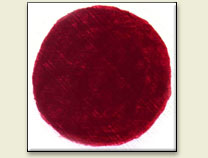
Brief description of Madder lake :
It's a lake derived from the extract of the madder plant's root (rubia tintorum) which the principle coloring substance is alizarin plus purpurin which is fading. It is one of the most stable natural pigments. It was in use by the ancient Egyptians for coloring textiles and then was continuosly used until today. By the 13the century, madder was being cultivated on a fairly large scale in Europe, but there is not evidence of its use in medieval or Renaissance painting. Madder lake was most widely used in the 18th and 19th century, though never as extensively as the ruby-like lakes made from kermes, cochineal, brazilwood, and lac. Madder was formerly used in large quantities for dyeing textiles and is still the color for French military cloth. The cultivation of madder root almost ceased after a synthetic method for making alizarin was discovered by German chemists, Graebe and Liebermann, in 1868.
Names for Madder lake :
| Alternative names: | Natural variety: garanza lake; Artificial variety: alizarin | ||||||
| Word origin: | The name "Madder lake " comes from Old English word mædere. | ||||||
| Non-English names: |
|
||||||
| Origin: | plant | ||||||
| Chemical name: | Alizarin (1,2-dihydroxyanthraquinone), |
Example of use by artists:
The madder lake gown

Jan Vermeer, Girl with a Wineglass, (1659-1660)
In the girl with a glasswine, Vermeer first modeled the gown of the girl in various tones of vermilion using white to lighten the tone and black to darken them. Once the area was dry it glazed with red madder deeping the orange tone of vermilion.

